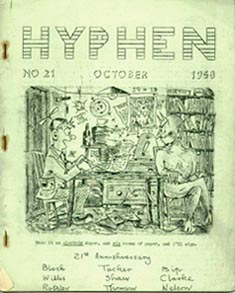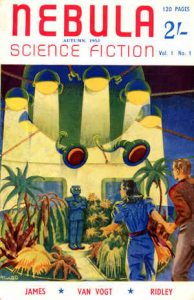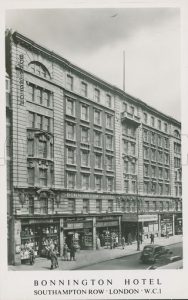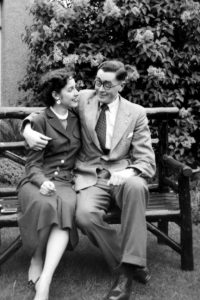This week on the blog we return to Rob Hansen’s Then – documenting the next instalment of the history of Irish fandom with a whizz around the world, a series of new fanzines, and a convention that celebrated the Coronation…
4. Transatlantic Travels.
In May 1952, Walt Willis launched a new fanzine, one originally intended to fill the gap between issues of SLANT but which actually replaced it. So SLANT’s seventh issue, earlier that year, was its last. Co-edited with Chuck Harris and rushed out in time for LONCON, the new zine was called HYPHEN and would go on to become perhaps the most celebrated fanzine of all time. (The second issue carried accounts, from both sides, of White’s ambush of Harris.)
The wit and warmth in Willis’s work, the skill and intelligence he brought to his writing were already working their potent magic in 1952 when American fan Shelby Vick organised a drive to bring him over to that year’s Worldcon in Chicago. This had started with a casual enquiry at the end of one of Vick’s letters to Willis in June 1951 as to whether there was any chance of Willis making it to NOLACON (that year’s Worldcon in New Orleans). In the postscript to a later letter, Vick announced that he was starting a contest that eventually developed into a campaign to bring Willis to the US for the 1952 Worldcon. The campaign’s slogan was ‘WAW With The Crew In ’52’. Neither Willis nor Hoffman thought the campaign would succeed, particularly as Willis was far less well known in the US in 1952 than Carnell had been when the Big Pond Fund was started and that had taken years to raise enough, but the money came in. Through auctions, donations, special fund-raising issues of their fanzines and the like, Sixth Fandom succeeded in raising enough to pay for the trip. Strangely, British fans had no part in the fund-raising. As Willis explained:
“I felt guilty about being invited to the States instead of fans who deserved it more, like Ken Slater, and had sort of kept the existence of it from British fandom.”
Not, however, from Chuck Harris who became the only British fan to contribute to the fund.
Willis set sail for America on 18th August 1952, and over the next six weeks travelled all over that vast land, meeting local fans and taking notes for a monumental trip report, ‘The Harp Stateside‘ (first published serially in various US fanzines and then, in 1957, in a collected edition), that rightly came to be regarded as one of the classic fannish works and set a standard for all later travelling fans to aspire to.
Nebula, #1
In the autumn the first issue of NEBULA, the Scottish prozine edited by the 18 year-old Peter Hamilton, made its appearance. Brian Aldiss, Robert Silverberg, and Bob Shaw would all have their first SF stories published by NEBULA. It carried a fannish column by Willis that appeared in all but one of the 41 issues it would see until its demise in June 1959. The column was titled ‘Fanorama’ (though re-titled ‘The Electric Fan’ by Hamilton for its first twelve installments).
(These can all now be read online here: http://efanzines.com/Willis/index.htm)
As the year drew to a close, Lee Hoffman stopped publishing QUANDRY in order to devote time to galloping around the Savannah, Georgia countryside on the horse she had recently bought, realising a longtime ambition. Since QUANDRY was seen as the axis around which Sixth Fandom revolved and since so many of its members were unusually quiet at that point, (Willis, for instance, had come down with pneumonia in the wake of his epic trip and had had to drop out for a few months), there were those who concluded that Sixth Fandom was dead, but reports of its death were premature.
American fan Bea Mahaffey, who at the time was also editor of the US prozine OTHER WORLDS, visited Ireland and the Willises on her way from the US to the 1953 UK national convention, and travelled over on the boat to Liverpool with them and James White. Here she was presented with a copy of the Liverpool group’s newly published symposium ‘Sex and Sadism’. Here also she got to meet one of Britain’s more colourful SF pros, as Willis relates:
“…Eric Frank Russell made his entrance. He stepped immediately into his natural niche as life and soul of the party, greeting Bea with the remark that while in his writing career he had often said what he would like to do to pro editors, he’d never imagined it could be a pleasure: and proceeded thus outrageously to skate on the thin ice on the brink of bad taste without once putting his foot in it. Larger than life and a great deal more interesting, he manages to set the standards in any company in which he finds himself.”
The Willises, White, and Mahaffey took the train down to London, meeting up with Chuck Harris (whose first convention this would be) at Euston and travelling over to the White Horse. It was here, at one point in the evening, that AUTHENTIC SF editor Bert Campbell, seeing Mahaffey in conversation with a group of Manchester fans, said: “For God’s sake, get her away from those bloody provincials!” This was not the sort of thing designed to smooth the ruffled feathers of already resentful Northerners, and afterwards a number wrote scathing convention reports with titles such as ‘A Bloody Provincial At The Fiascon’. In fact, despite organisational problems and the shambles this made of much of the programme, CORONCON would be the first to break the mould of the traditional British SF convention. Thanks partly to Willis’s trip to the US, and to a subsequent scanning of American convention reports, British fans were determined to put on a con as lively as those they were reading about. This was to prove very much a case of life imitating art, since many of those reports had been wildly exaggerated….
The Bonnington Hotel – now permanently closed.
The 1953 national convention, held at the Bonnington Hotel on London’s Southampton Row over Whitsun weekend (Saturday 23rd May – Sunday 24th), was important in that it can justifiably be regarded as the first modern British SF convention, setting the pattern for all those that came after. This being the year of the Coronation of Queen Elizabeth II, the convention was dubbed CORONCON (‘LADIES & TEENAGERS may attend for HALF PRICE!’, boasted the flyer) and among the new ideas to emerge there were name-badges, James White’s zap-guns (aka water pistols), and room-parties. The greatest innovation of all, however, was the abandonment of the official programme, until then almost sacrosanct. It was full of gaps, had many items cancelled, and ran late but while some sat and complained others, realising the possibilities of this unwitting liberation, went off to party at the homes of various local fans. An important change had begun to take place, one that would reach fruition at the following year’s convention, the SUPERMANCON.
Bea Mahaffey and James White at Coroncon.
CORONCON was also the occasion when Carnell, during his Chairman’s address, made first public mention of a fund that had been started by the Cincinnatti Fantasy Group to bring Norman Ashfield over for PHILCON, the ’53 Worldcon. Ashfield hadn’t been active in fandom for some time but he had kept up his correspondence with Cincinnati’s Don Ford and this fund had resulted. As it turned out, Ashfield was unable to make the trip so the CFG were generously throwing the fund open to any fan that UK fandom felt deserved it. However, since there wasn’t time either to organise a trip to Philadelphia or to choose a suitable candidate it was decided instead to use the CFG donation as seed-money for a permanent fund to help US and UK fans to attend each other’s conventions. The Willis trip provided the model and the inspiration, and the basics of the scheme — the permanent system of financing trans-Atlantic trips and the organisational structure needed to make it self-sustaining — were hammered out at CORONCON ready for the first UK to US race the following year. Walt Willis was to administer the fund on this side of the Atlantic and Don Ford would be asked to administer it on the other, each to be replaced in that position by the first fundwinners on their side, and they in turn to be replaced by the next, and so on. In no time, Vince Clarke, Derek Pickles, Ken Slater, Tony Thorne, and James White had been nominated for the first race and details were announced in HYPHEN. Thus was born TAFF, the Trans-Atlantic Fan Fund.”
(In-depth coverage of CORONVENTION, with photos, can be found here)
‘Then’ on the Dublin 2019 Blog:
Prologue
Part 1 Belfast Rising
Part 2 Going International
Part 3 Hoaxes and Cons
Rob Hansen’s Then (A work always in progress) at Ansible.





